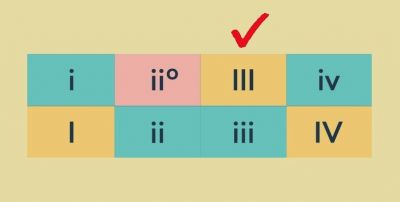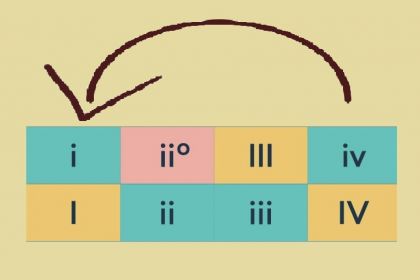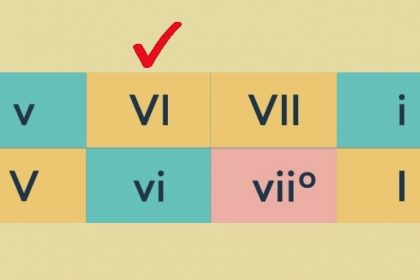Music Theory
Popular songs showing the mediant chord in all diatonic modes

Roman numerals indicating chords of minor and major scales
In musical theory, the mediant refers to the third scale degree of the diatonic scale, and the triad rooted in the third scale degree is therefore often called the mediant chord. In the seven diatonic scales forming the basis of their respective modes, the major mediant triad is present in the Aeolian, Phrygian, and Dorian modes; the minor mediant triad is found in the Ionian, Lydian, and Locrian modes; and the diminished mediant triad is built on the third scale degree in the Mixolydian mode.
Following the principles of harmonic analysis, chords are usually denoted by Roman numerals with capitalized numbers used for major chords and lowercase numbers reserved for minor chords. Thus, mediant chords rooted in the third scale degrees can be designated as III, iii, and iii0 for a diminished chord.
Harmonic analysis postulates that all chords of a certain diatonic mode interact in the context of the three harmonic functions of the tonic, dominant, and subdominant. Depending on its position in chord progressions, the mediant chord can be attributed to both tonic and dominant functions.
The Aeolian mode, also known as the natural minor, offers the most comfortable environment for applying III mediant chords due to the starting point of the relative major scale falling on the third degree of a natural minor scale. In other words, the Aeolian mediant chord simultaneously acts as the tonic chord of the Ionian mode.
Well-developed E Aeolian sequences that contain mediant chords can be heard in the 1963 track Not A Second Time by The Beatles. In the verses, the alternation of the triads G–Em, rooted in the third and first scale degrees, creates an illusion that the song is written in G relative major key:
- G–Em–G–Em–D–G–D7 or III–i–III–i–VII–III–VII7
- G–Em–G–Em–D–Am7–D7 or III–i–III–i–VII–iv7–VII7
Two more progressions, appearing in all choruses and the solo, demonstrate the juxtaposition of the subdominant and dominant diatonic functions in a manner typical of classical music:
- Am7–Bm7–G–Em or iv7–v7–III–i
- Am–Bm–D7–Em or iv–v–VII7–i
The strong emotional tension is created by the instances in which the dominant fifth-degree Bm chord strictly follows the subdominant fourth-degree Am chord, generating the expectation that practically any chord of the tonic function may follow suit. In the first line, the tension is resolved by the mediant G triad, while in the second line the subtonic D7 chord expands the dominant function to establish the tonic Em triad at the end of the musical phrase.
Listen to Not A Second Time by The Beatles:
Listen to Not A Second Time by The Beatles:
Various examples of the mediant chord used in the Aeolian mode can be found in Red Hot Chili Peppers' Dani California, Katy Perry's Part Of Me, Kiss' I Was Made for Loving You, and Iron Maiden's The Trooper which harmonic analysis is outlined in the article on the Aeolian mode and natural minor scale.
Although classical music rarely shows the iii minor mediant chord in the Ionian mode, popular songs give ample examples of third-degree triads being used in the major mode. One of these cases is I Need You by The Beatles, and its harmonic analysis is detailed in the article on Ionian mode and the major scale.
In the Phrygian mode, the III major mediant triad is quite euphoniously combined with the supertonic major chord, considered to be the highlight of Phrygian songs and is often referred to as the Neapolitan chord. Examples of this interaction between third- and second-degree chords are found in Tame Impala's New Person, Same Old Mistakes and Beyoncé's I Care. The harmonic analysis of both can be seen in the article on the Phrygian mode and Neapolitan chord.
As this article on the Dorian mode suggests, the III mediant chord is applied here in the same way as in the natural minor. Harmonic analysis reveals the mediant triad involved in these five songs: Another Brick In The Wall by Pink Floyd, famous sea shanty Drunken Sailor in an arrangement by The Irish Rovers, the traditional English ballad Scarborough Fair as performed by Simon & Garfunkel, Mad World by Tears for Fears, and Sweet Lullaby by Deep Forest.
In the Lydian mode, the iii minor mediant chord appears in various combinations that often interact with the dominant fifth-degree triad. Michael Jackson's Human Nature as well as Fleetwood Mac's Dreams and Landslide which use third-degree chords are analyzed in this article explaining the Lydian mode.
The fact that the iii0 mediant triad in the Mixolydian mode is a diminished chord virtually eliminates its use in popular music where diminished chords are generally not introduced. Nevertheless, there are examples where the ♭III Mixolydian mediant chord, rooted in the lowered third scale degree, is applied. Coldplay's Clocks and Lynyrd Skynyrd's Sweet Home Alabama contain chords built on a lowered third degree, as follows from their harmonic analysis given in the article on the Mixolydian mode.
Of all seven diatonic scales, only the Locrian scale contains the interval of a diminished fifth which divides the first and fifth scale degrees. This means that the tonic triad of the Locrian mode is a strongly dissonant diminished chord that cannot provide a stable tonic function, making the Locrian mode mostly theoretical.



